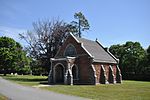Buttonwood Park Zoo

The Buttonwood Park Zoo, located in New Bedford, Massachusetts, is a zoo located in the center of Buttonwood Park. Opened in 1894, it is the third-oldest zoo in New England and the 12th-oldest zoo in the United States. Located on a 7 acres (2.8 ha) campus, the zoo is owned and operated by the City of New Bedford, with the support of the Buttonwood Park Zoological Society. It is located on part of the Buttonwood Park Historic District, and federally designated on the National Register of Historic Places. The zoo is home to more 250 different animals made up of more than 80 different species of animals, including many that are rare and endangered. The zoo has played a vital role in the conservation of endangered animals and is a participant in the Cape Cod Stranding Network and Species Survival Plan.
Excerpt from the Wikipedia article Buttonwood Park Zoo (License: CC BY-SA 3.0, Authors, Images).Buttonwood Park Zoo
Pauline Street, New Bedford
Geographical coordinates (GPS) Address External links Nearby Places Show on map
Geographical coordinates (GPS)
| Latitude | Longitude |
|---|---|
| N 41.62996 ° | E -70.95273 ° |
Address
Buttonwood Park Zoo
Pauline Street
02740 New Bedford
Massachusetts, United States
Open on Google Maps








